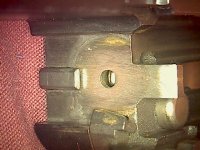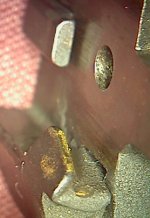You are using an out of date browser. It may not display this or other websites correctly.
You should upgrade or use an alternative browser.
You should upgrade or use an alternative browser.
Problems with reloading my first .45 ACP rounds
- Thread starter k2man
- Start date
Ok, so I did load three dummy rounds at 1.240" COL so that I could test how much force it would take to push the bullet further into the case. I used a bathroom scale and pushed a bullet down on it (between two pieces of wood). I couldn't push hard enough to make the bullet move. So I got a channel locks and, using the scale to measure force, I put the cartridge in the pliers, squeezed the pliers by pushing the one handle squarely into the scale. The pliers gave me a force multiplier of at least 10x - I forgot to measure the lengths of each lever - and no attempt to measure the friction of the pliers pin. But the bullet didn't slip in the brass until I reached about 37 lbs. So I figure it takes something like 350 to 400 lbs. to push the bullet out of the brass. Sounds pretty excessive to me.
F. Guffey, does sound like half sizing would not decrease the brass diameter as much at the mouth as full sizing will do. That would hopefully eliminate the bulging brass. I'll try that.
I did shoot six rounds that I pressed down to 1.240 COL. I chrono'ed these, and was getting a very consistent 840 fps. Fast enough. Actually faster than I had expected, but good info. I'll load some at .1, .2 and .3 grains less to see what their speeds are, but I'd like to shoot about 850.
However, I had a totally new issue surface. The primer and the back of the brass had a big scuff mark across them - about as wide as the primer. Not deep, but a definitely visible with the naked eye scuff mark. Any ideas on what is causing this and how to fix it?
F. Guffey, does sound like half sizing would not decrease the brass diameter as much at the mouth as full sizing will do. That would hopefully eliminate the bulging brass. I'll try that.
I did shoot six rounds that I pressed down to 1.240 COL. I chrono'ed these, and was getting a very consistent 840 fps. Fast enough. Actually faster than I had expected, but good info. I'll load some at .1, .2 and .3 grains less to see what their speeds are, but I'd like to shoot about 850.
However, I had a totally new issue surface. The primer and the back of the brass had a big scuff mark across them - about as wide as the primer. Not deep, but a definitely visible with the naked eye scuff mark. Any ideas on what is causing this and how to fix it?
polyphemus
New member
It sounds pretty unnecessary to me.Sounds pretty excessive to me.
Under normal circumstances properly loaded cartridges will not experience bullet setback,friction alone will hold it for a handful of chamberings and sometimes more.Taper crimping .45 AUTO is optional anyway and in any case
is not done to hold the bullet but to iron out remaining bell mouth.This experiment of yours does not show anything useful since your method can not
be replicated.
It would be helpful to show what it looks like so people don't have to guess.The primer and the back of the brass had a big scuff mark across them
F. Guffey, does sound like half sizing would not decrease the brass diameter as much at the mouth as full sizing will do.
It seems trending on reloading forums is about ‘discovering’ new words for 'old terms’ so I had a go at it. I used a carbide RCBS full length sizing die to size enough of the case to eliminate ‘the bulge’, 'the bullet line’. And it was necessary to remove the primer punch assemble.
All I was trying to do is make the 45 ACP 1911 think I had purchased new, factory over the counter.
I have three complete slides for one pistol; I am not the fan of shooting lead and then jacketed bullets without cleaning after shooting lead.
F. Guffey
Last edited:
Many years ago I visited Dillon in Arizona, they claimed crimping and seating on the same station was a bad habit. Not a problem for me, one of my presses could not be outnumbered because it was a Herter 6 position turret. Beyond that it was possible to turn the 6 position into a 12 position turret. What that means I had no problem seating on one position and crimping on another.
Point; if I purchases a Dillon 550 I had to purchase Dillon dies because they had one die to seat and another to crimp. It was about that time I told them I did not need their press because I was not starting over with a new set of dies for everything I load. It was about that time they decided I could use my dies.
Back to the beginning; Lyman thought crimping was a bad habit, they thought the crimp could lesson bullet hold meaning when the crimp is applied the bullet is moving down and if the crimp bites into the bullet the case below the crimp will bulge and that, they said, lessoned bullet hold. After that someone invented ‘neck tension’. I could not figure a way to measure neck tension without tension gages so I stuck with bullet hold.
I am the only reloader that can not measure tension because I do not have gages that measure in tensions. I have strain gages, I have tension gages, all of my strain gages are calibrated in pounds or deviation.
Point? If the bullet is seated and crimped good luck on adjusting the case overall length with out reducing bullet hold.
F. Guffey
Point; if I purchases a Dillon 550 I had to purchase Dillon dies because they had one die to seat and another to crimp. It was about that time I told them I did not need their press because I was not starting over with a new set of dies for everything I load. It was about that time they decided I could use my dies.
Back to the beginning; Lyman thought crimping was a bad habit, they thought the crimp could lesson bullet hold meaning when the crimp is applied the bullet is moving down and if the crimp bites into the bullet the case below the crimp will bulge and that, they said, lessoned bullet hold. After that someone invented ‘neck tension’. I could not figure a way to measure neck tension without tension gages so I stuck with bullet hold.
I am the only reloader that can not measure tension because I do not have gages that measure in tensions. I have strain gages, I have tension gages, all of my strain gages are calibrated in pounds or deviation.
Point? If the bullet is seated and crimped good luck on adjusting the case overall length with out reducing bullet hold.
F. Guffey
polyphemus
New member
You can take a pistol to a gunsmithing class but you can't make it think.All I was trying to do is make the 45 ACP 1911 think
ROFLYou can take a pistol to a gunsmithing class but you can't make it think.
Ok, figured out photos finally so here's a photo of the scrape on the back of the brass. My big concern is that it is scraping the primer - not a worry if the scrape is after it's been fired. I think I answered that question after looking at the photo. The primer has been fired before the scrape happened - the indent of the firing pin does not appear to be scraped.
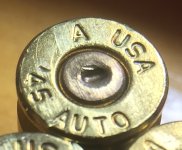
polyphemus
New member
That looks like firing pin bounce or drag.Either way a stiffer firing pin spring usually resolves the issue,if factory ammo don't do it then you might consider
reducing your powder charges.
reducing your powder charges.
more scrape photos
I took more photos of the scrape marks. They are all very consistently about 10 degrees off of perpendicular to the long side of the firing pin. The firing pin cannot be making these marks as they go from edge to edge across the whole base of the brass and the scrape is much wider than the firing pin. The scrapes definitely occurred after firing as the indent around the firing pin has no marks.


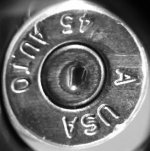
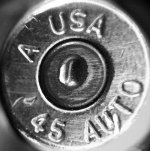
I took more photos of the scrape marks. They are all very consistently about 10 degrees off of perpendicular to the long side of the firing pin. The firing pin cannot be making these marks as they go from edge to edge across the whole base of the brass and the scrape is much wider than the firing pin. The scrapes definitely occurred after firing as the indent around the firing pin has no marks.


ROFL
If we are talking about a 1911 ACP type pistol it would help for you to understand the sequence of events that follow pulling the trigger. The case drives the slide back. Long before the slide reaches the ejector the hammer is cocked, I do not believe the hammer has time to bounce. Then there is that sudden stop at the rear.
Then there is another problem, I got a call from a smith/shooter/reloader; he put a hole through the roof when he loaded his champion shooting/Perry winning 45 ACP. He had a friend look at the pistol; after our friend put the pistol through its paces he had two holes in the roof.
I suggested closing a slide on a 45 ACP with a stuck firing pin can cause that.
Because we are older and more mature we find no humor in laughing at, we do find time to laugh with.
F. Guffey
I would suggest you mark your cases to index the position of the round in the chamber.
polyphemus
New member
Looking again,the primer indent has to be caused by the pin,can't think what else might do it.
The scrape across the head is more puzzling,I would look for a burr on the breech face or even on the magazine,it goes clear across and that eliminates the firing pin because the round can't travel further up than the guide blocks allow and that's half way.You'l have to break out the old loupe and carefully
look and feel,good luck.
The scrape across the head is more puzzling,I would look for a burr on the breech face or even on the magazine,it goes clear across and that eliminates the firing pin because the round can't travel further up than the guide blocks allow and that's half way.You'l have to break out the old loupe and carefully
look and feel,good luck.
Thanks polyphemus, I'll have to examine the (Springfield 4.0" XDS). Was hoping someone else had seen this in an XDS or maybe other Springfield at least. I don't recall ever seeing it in any range pickup brass, so it really has me wondering.
I will also try loading some with a little less powder - but I'm only .3 gn. over the minimum book value - although this isn't the exact bullet. I'm using a Bayou powder coated bullet and the data for a Berry plated bullet - but pushing the bullet in further than Berry's recommended 1.250" (I'm using 1.240") Don't know what the length of the Berry's is compared to the Bayou though.
It seems like dropping below 7.1 gn. of AA#5 should not be a problem as I am getting higher velocities than expected at 7.4 grains. I will first load some to 7.1, shoot them, see if I still get the scrape marks, if so, drop down to a few tenths and see if that does it. I do want to shoot these at around 850 fps, so I'll have to figure out the scraping.
I will also try loading some with a little less powder - but I'm only .3 gn. over the minimum book value - although this isn't the exact bullet. I'm using a Bayou powder coated bullet and the data for a Berry plated bullet - but pushing the bullet in further than Berry's recommended 1.250" (I'm using 1.240") Don't know what the length of the Berry's is compared to the Bayou though.
It seems like dropping below 7.1 gn. of AA#5 should not be a problem as I am getting higher velocities than expected at 7.4 grains. I will first load some to 7.1, shoot them, see if I still get the scrape marks, if so, drop down to a few tenths and see if that does it. I do want to shoot these at around 850 fps, so I'll have to figure out the scraping.
polyphemus
New member
ok man,this is a striker fired pistol so my suggestions are not entirely accurate,
my understanding is that the double indent is not unusual for that type gun and
not that serious anyway,the scrape across the head is unusual but I'm sure with a little patience you can find the cause.
my understanding is that the double indent is not unusual for that type gun and
not that serious anyway,the scrape across the head is unusual but I'm sure with a little patience you can find the cause.

